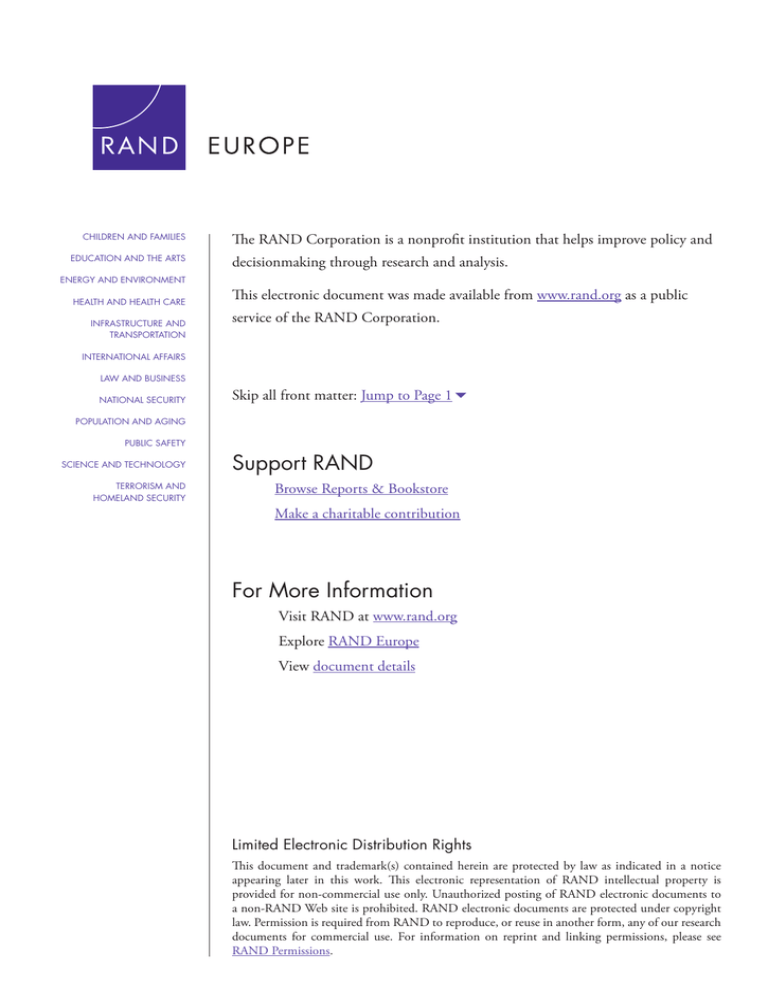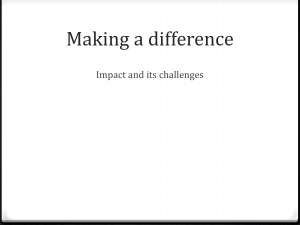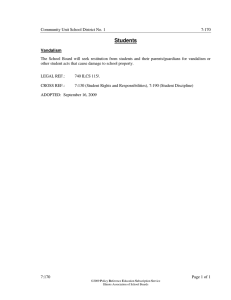The RAND Corporation is a nonprofit institution that helps improve... decisionmaking through research and analysis.
advertisement

CHILDREN AND FAMILIES EDUCATION AND THE ARTS The RAND Corporation is a nonprofit institution that helps improve policy and decisionmaking through research and analysis. ENERGY AND ENVIRONMENT HEALTH AND HEALTH CARE INFRASTRUCTURE AND TRANSPORTATION This electronic document was made available from www.rand.org as a public service of the RAND Corporation. INTERNATIONAL AFFAIRS LAW AND BUSINESS NATIONAL SECURITY Skip all front matter: Jump to Page 16 POPULATION AND AGING PUBLIC SAFETY SCIENCE AND TECHNOLOGY TERRORISM AND HOMELAND SECURITY Support RAND Browse Reports & Bookstore Make a charitable contribution For More Information Visit RAND at www.rand.org Explore RAND Europe View document details Limited Electronic Distribution Rights This document and trademark(s) contained herein are protected by law as indicated in a notice appearing later in this work. This electronic representation of RAND intellectual property is provided for non-commercial use only. Unauthorized posting of RAND electronic documents to a non-RAND Web site is prohibited. RAND electronic documents are protected under copyright law. Permission is required from RAND to reproduce, or reuse in another form, any of our research documents for commercial use. For information on reprint and linking permissions, please see RAND Permissions. This product is part of the RAND Corporation corporate publication series. Corporate publications describe or promote RAND divisions and programs, summarize research results, or announce upcoming events. Impact and the Research Excellence Framework: new challenges for universities The 2014 Research Excellence Framework (REF) places new emphasis on the non-academic outputs of research. Impact statements and related case studies prepared for the REF will be a primary means of focusing attention on this type of impact. This element adds an additional dimension to the evaluation process and presents universities with a new challenge: how best to construct submissions and present research results to capture these outputs. In order to help universities prepare for the REF, RAND Europe and Ranmore Consulting Group have devised an analysis and advice package to help senior research leaders determine how best to identify research with the greatest impact and present this research to the REF panels. Also, they will help universities deal with the process of addressing the inevitable people management challenges associated with the REF submission. The package was piloted across two institutions to inform and support their REF preparation. The pilot demonstrated the value of raising awareness about the impact element of REF, establishing a timetable within the institutions to identify and develop case studies, and provided critical review on case studies and impact statements. Building on RAND Europe’s expertise in evaluating research impact, including previous work for the Higher Education Funding Council for England (HEFCE) in developing the REF,1 and Ranmore’s work with senior level leaders in higher education institutes (HEIs),2 the partnership is a unique relationship that will help universities meet the new challenges posed by the 2014 REF. Building up to the REF Universities will be invited to make REF submissions in November 2013 and the results will be published in 2014. Although the final guidelines on panel criteria and working methods will not be published until January 2012, REF will assess universities on the basis of the quality of research outputs, the wider impact of research and the vitality of the research environment. Following the impact pilots, the funding councils have concluded that using case studies, and evaluating the impact of those case studies through assessment panels, is a workable approach. The likely criteria and working methods for assessing impact are described in the draft consultation guidance published by the four main panels in July 2011. The weighting for the impact assessment part of the REF will be 20% of the total assessment in 2014, and this is likely to rise to 25% in the future. Even at 20%, this equates to around £220m per year, and so constitutes a significant amount of funding for research. With so much riding on a positive outcome from this new assessment method, it is imperative for universities to be able to successfully identify and present their most impactful research. It is equally important that universities are able to consider strategies for managing the implications of the REF-associated selection and implementation processes on their talent pool and research activity. 1 RAND Europe was commissioned to produce several reports for HEFCE in relation to the REF, including the area of bibliometrics (see: http://www.hefce.ac.uk/research/ref/resources/impact.pdf and http://www.hefce.ac.uk/research/ref/resources/Options.pdf), and in the broader domain of capturing research impact (see: http://www.rand.org/pubs/documented_briefings/DB578.html). 2 For further examples of Ranmore’s work in this area, see: http://www.ranmore.co.uk/ranmore.aspx?page=54. Ranmore is also active in the research and development area: see for example a report for the Leadership Foundation for Higher Education (LFHE), entitled ‘The Composition, Challenges and Changes in Top Teams in Higher Education Institutions’ (2008 with S. Woodfield, see: http://www.lfhe.ac.uk/publications/research.html). 1 The ImpactFinder In light of the challenges posed to the HEI sector by the 2014 REF, we are offering an analysis and advice package to support universities in their preparations and, crucially, to help them evaluate the impact of their research portfolios. At its core is the RAND Europe ImpactFinder tool – a proven methodology for identifying impactful research. The ImpactFinder methodology was developed initially for the Arthritis Research Campaign3 and is now used by a number of research funders. For example, it is being rolled out across the National Institutes of Health Research to evaluate high-quality research and health impacts, and has formed the basis of the Medical Research Council’s evaluation system. The ImpactFinder provides an overview of research impact and a basis for more detailed examination of the ‘why and how’ of research translation. The tool is implemented as a web questionnaire and collects information across a range of social, cultural and economic impacts. We have established a demonstration site that can be accessed at: http://demo.impactfinder.org/. The data are presented in ‘impact arrays’, which have been developed as a way to display the impacts of research and give an instant overview of the research portfolio. An example of an impact array is shown below: the columns represent different types of outputs and impacts, the rows different projects, and the colouring the intensity or geographic reach of an impact. The presentation of research impact in this way will provide the university with a valuable visual demonstration of impact across its entire research portfolio, as well as the means to select case studies for more in-depth qualitative analysis and begin to collate the evidence needed to demonstrate impact. Example of an impact array generated by the ImpactFinder Rows represent different researchers Columns represent different types of research outputs and impacts, darker colours represent wider impact The analysis and advice package We have developed two different packages – the first is aimed at a single UOA and involves the senior briefing workshop, fielding and analysing the survey for a UOA, facilitating a workshop to interrogate the results of the survey, critical review of 10 case studies or impact statements, and a simulation peer review panel. The second package is the same but the survey will be for all submitting UOA and will involve the critical review of 20 cases studies or impact statements. In each case, we will work with the university to develop a comprehensive approach suitable for their needs and strategic challenges. The key stages of this analysis and advice package are summarised in the figure below. 3 ‘Mapping the Impact: Exploring the Payback of Arthritis Research’, available at: http://www.rand.org/pubs/monographs/MG862.html. 2 As partners, RAND and Ranmore will bring an extensive knowledge base of the university sector, the research funding landscape, and cutting-edge research evaluation techniques to the university and REF preparations. The evaluations of the REF Impact Pilot stressed that universities must begin to prepare immediately for the 2014 REF. We hope that our analysis and advice package might be a helpful part of the university’s preparation. Stages of REF analysis and advice package for higher education institutes Stage 1: Identify impact • Run a facilitated workshop with key academic and administrative leads for REF to support: • Selection/short-listing of case studies • Identification of supporting evidence needed • Planning the process for drafting case studies • The workshop will also support you in defining your REF and research strategy and in managing political and people issues Stage 2: Preparation workshop Stage 3: C ritical review • Second facilitated workshop to provide critical peer review on the case studies. • Organisation of simulation peer review panel for case studies, drawing on academics within university or from external experts (where appropriate) • Continued development and refinement of your REF strategy • Production of a final report to capture feedback and support final revision/iterations of case studies • Senior briefing meeting on impact assessment and REF •Use RAND Europe ImpactFinder survey to identify impactful research • Analysis of survey data and identification of candidates for impact case studies • Delivery of report to HEI on overall impact across the all disciplines Stage 4: Simulation review panel and handoff • Critical review of draft case studies and impact statements by senior RAND Europe and/or Ranmore researchers and associates. • Review will focus on case study coherence and strength of supporting evidence • 10 or 20 case studies/impact statements included depending on package. More can be reviewed on request RAND Europe is an independent not-for-profit public policy research institute that helps to improve policy and decision making through research and analysis. The RAND Europe team has extensive experience in the evaluation of the impact of research and has worked across a range of sectors and disciplines, including the biomedical sciences, social sciences and humanities, international research evaluation practices, education and health systems. For more information, see www.rand.org/randeurope or contact Jonathan Grant, President of RAND Europe at: jgrant@rand.org. Ranmore Consulting Group specialises in facilitating strategic planning, leadership development and change activities in the higher education and other sectors. It brings firsthand experience of working with more than half of the HEIs in the UK. The Ranmore network includes those with expertise in strategic planning, developing research leadership, change management and coaching. For more information, see www.ranmore.co.uk or contact Tom Kennie, Director of Ranmore at: tkennie@ranmore.co.uk. 3 Relevant publications HEFCE publications on impact and REF 2014 ‐ REF 03.2011 Consultation on draft panel criteria and working methods (July 2011) http://www.hefce.ac.uk/research/ref/pubs/2011/03_11/ ‐ Analysis of panel membership (July 2011) http://www.hefce.ac.uk/research/ref/pubs/other/member/ ‐ REF 02.2011 Assessment framework and guidance on submissions (July 2011) (Printed copies available) http://www.hefce.ac.uk/research/ref/pubs/2011/02_11/ ‐ Guidance to panels (July 2011) http://www.hefce.ac.uk/research/ref/pubs/other/guide/ ‐ Equality briefing for panels (July 2011) http://www.hefce.ac.uk/research/ref/pubs/other/equality/ ‐ REF 01.2011 Decisions on assessing research impact (March 2011) http://www.hefce.ac.uk/research/ref/pubs/2011/01_11/ ‐ REF 01.2010 Units of assessment and recruitment of expert panels (July 2010) http://www.hefce.ac.uk/research/ref/pubs/2010/01_10/ ‐ REF Research Impact Pilot Exercise Lessons-Learned Project: Feedback on Pilot Submissions - Technopolis (November 2010) http://www.hefce.ac.uk/research/ref/pubs/other/re02_10/ ‐ Research Excellence Framework impact pilot exercise: Findings of the expert panels (November 2010) http://www.hefce.ac.uk/research/ref/pubs/other/re01_10/ See http://www.hefce.ac.uk/research/ref/about/background/ for additional background documents on the REF. Further information on measuring the impact of research Brutscher, P-B., S. Wooding and J. Grant. 2008. Health Research Evaluation Frameworks: An International Comparison. RAND Europe. http://www.rand.org/pubs/technical_reports/TR629.html Canadian Academy of Health Sciences. (2009). Making an Impact: A Preferred Framework and Indicators to Measure Returns on Investment in Health Research. Report of the Panel on the Return on Investments in Health Research, January. http://www.cahs-acss.ca/making-an-impact-a-preferred-framework-and-indicators-to-measure-returns-on-investment-inhealth-research-8/ Donovan, C. 2005. A review of current Australian and international practice in measuring the quality and impact of publicly funded research in the humanities, arts and social sciences. REPP Discussion Paper 05/3. Grant, J. Brutscher, P-B., Guthrie, S. Butler, L. and Wooding, S. (2009). Capturing Research Impacts: A review of international practice. Cambridge, UK: RAND Europe. Prepared for HEFCE. http://www.hefce.ac.uk/pubs/rdreports/2009/rd23_09/ Kennie, T.and S. Woodfield. (2008). ‘The Composition, Challenges and Changes in Top Teams in Higher Education Institutions’. Leadership Foundation for Higher Education (LFHE), see: http://www.lfhe.ac.uk/publications/research.html Peacock, J., L. Harvey, M. Barber, P. McFadden, J. Marceau, I. Davey, P. Clark, C. Fell, W. King, T. Enright, D. Schreuder and I. Smith. 2006b. Research Quality Framework. Assessing the quality and impact of research in Australia: Research Impact. Development Advisory Group for the RQF. Peacock, J., L. Harvey, M. Barber, P. McFadden, W. King, T. Enright, D. Schreuder, I. Smith, J. Marceau, I. Davey, P. Clark and C. Fell. 2006a. Research Quality Framework. Assessing the quality and impact of research in Australia: The Recommended RQF. Development Advisory Group for the RQF. Roberts, G., E. Arthur, M. Barber, R. Batterham, P. Callaghan, I. Chubb, P. Clark, A. Edwards, P. Hoj, R. Milbourne, A. Pettigrew, P. Sheehan and I. Smith. 2005. Research Quality Framework. Assessing the quality and impact of research in Australia: The Preferred Model. Expert Advisory Group for the RQF. Tremblay, G., Zohar, S., Bravo, J., Potsepp, P. and Barker, M. (2010). The Canada Foundation for Innovation’s outcome measurement study: a pioneering approach to research evaluation Research Evaluation, 19(5), December, pages 333–345. http://www.innovation.ca/en/evaluation/outcome-measurement-study-oms CP-661 4



